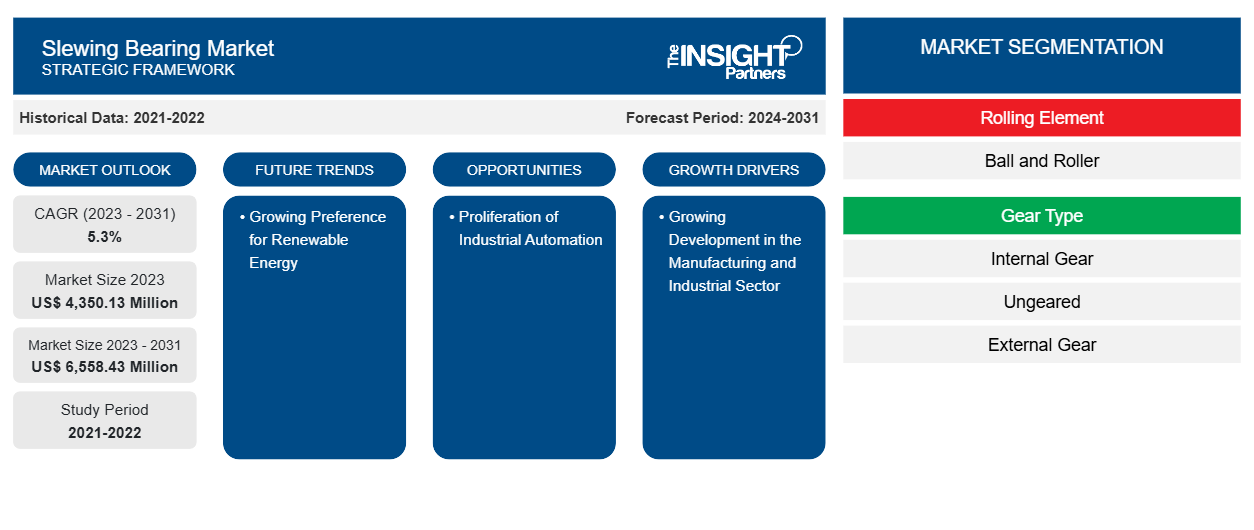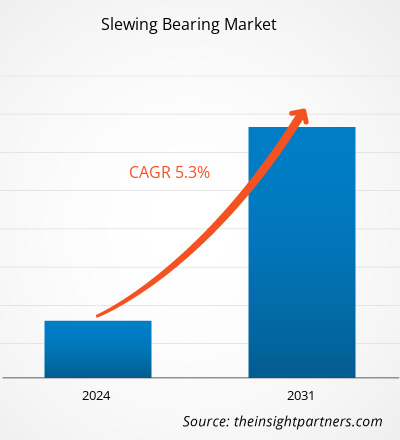The slewing bearing market size is projected to reach US$ 6,558.43 million by 2031 from US$ 4,350.13 million in 2023. The market is expected to register a CAGR of 5.3% during 2023–2031. The mounting focus on renewable energy and rising emphasis on infrastructure development is likely to remain a key trend in the market.
Slewing Bearing Market Analysis
The growing government initiatives for supporting the manufacturing sector are one of the prime supporting factors for the slew bearing market. The rising government initiatives offer various benefits to manufacturing companies located in the region and propel the growth of the manufacturing sector in the country. Thus, influencing the market growth of slew bearings. Moreover, the development of the mining sector is among other factors contributing to the growth of the market.
Slewing Bearing Market Overview
The economically advanced regions like Europe and North America have a larger number of businesses in the manufacturing sector; those also have established their bases in these regions, giving rise to employment and contributing to the high GDP of the countries.. UK, Spain, Italy, France, Germany, Switzerland, Russia, Austria, Sweden, and the Netherlands are some of the countries having very high potential in the slew bearing market. Developing economies in the Asia Pacific, such as India and China, have realized the importance of a digital economy, and the government has started various projects on the path towards it, which is driving the development of the manufacturing and construction sector in the region, thus positively influencing the skew bearing market.
Customize This Report To Suit Your Requirement
You will get customization on any report - free of charge - including parts of this report, or country-level analysis, Excel Data pack, as well as avail great offers and discounts for start-ups & universities
Slewing Bearing Market: Strategic Insights

-
Get Top Key Market Trends of this report.This FREE sample will include data analysis, ranging from market trends to estimates and forecasts.
Slewing Bearing Market Drivers and Opportunities
Growing Development in Manufacturing and Industrial Sector to Favor Market
The governments of various developed countries like the US have taken various initiatives to support the manufacturing sector in the country. This includes programs such as Advanced Manufacturing Technology Consortia, Manufacturing USA, MForesight, SelectUSA, Investing in Manufacturing Communities Partnership, Materials Genome Initiative, National Export Initiative, Sustainable Manufacturing Clearinghouse, and The MEP National Network, among others. These initiatives provide various benefits to the manufacturing companies located in the region and propel the growth of the manufacturing sector in the country. Thus, influencing the market growth. The high presence of manufacturing companies located in Europe benefitted from the developed facilities available. Being a powerful economy allows companies to spend more on innovations that facilitate the growth of upcoming technologies. Significant investments can bring about more growth in the slew bearing market globally.
Growing Preference for Renewable Energy
The slew bearing demonstrates a very crucial role in the renewable energy sector as it has high application in electrical load bearing machinery. The growing government focus on boosting the development of the renewable energy sector is also fueling the demand for slew bearings globally. Rising government initiatives to increase the share of renewable energy stake in the overall energy mix are also driving the development of the renewable energy sector, thus positively influencing the application of slew bearings.
Slewing Bearing Market Report Segmentation Analysis
Key segments that contributed to the derivation of the slewing bearing market analysis are rolling element, gear type, and application.
- Based on the rolling element, the slewing bearing market is divided into roller and ball. The ball segment held a larger market share in 2023.
- By gear type, the market is segmented into internal gear, ungeared, and external gear. The internal gear segment held a significant share of the market in 2023.
- By application, the market is segmented into aerospace and defense, wind and solar energy, medical, industrial machinery, oil and gas, mining, and others. The industrial machinery segment held a significant share of the market in 2023.
Slewing Bearing Market Share Analysis by Geography
The geographic scope of the slewing bearing market report is mainly divided into five regions: North America, Asia Pacific, Europe, Middle East & Africa, and South & Central America.
Asia Pacific is leading the market. The rising population is heightening the demand for electricity, which is also driving the renewable energy sector, thus influencing the growth of slew bearing market positively in the region. The governments of numerous countries of the Asia Pacific region are taking steps to boost their country’s induistrial and manufacturing sector. Some of these initiatives include providing tax rebates, subsidiaries, funds, and other such provisions to support the manufacturing industry. Moreover, countries such as China, India, South Korea, and others are focusing on increasing the solar and wind contribution to their respective energy mix. Asia Pacific is a hub for manufacturing industries. This region, particularly countries including China, India, Japan, Taiwan, and Korea, among others, are of the biggest exporters of goods, products and services. For instance, China holds a lion’s share in vehicle production globally. The presence of a strong manufacturing sector will help the market to grow in the region.
Slewing Bearing Market Regional InsightsThe regional trends and factors influencing the Slewing Bearing Market throughout the forecast period have been thoroughly explained by the analysts at The Insight Partners. This section also discusses Slewing Bearing Market segments and geography across North America, Europe, Asia Pacific, Middle East and Africa, and South and Central America.
Slewing Bearing Market Report Scope
| Report Attribute | Details |
|---|---|
| Market size in 2023 | US$ 4,350.13 Million |
| Market Size by 2031 | US$ 6,558.43 Million |
| Global CAGR (2023 - 2031) | 5.3% |
| Historical Data | 2021-2022 |
| Forecast period | 2024-2031 |
| Segments Covered |
By Rolling Element
|
| Regions and Countries Covered |
North America
|
| Market leaders and key company profiles |
|
Slewing Bearing Market Players Density: Understanding Its Impact on Business Dynamics
The Slewing Bearing Market is growing rapidly, driven by increasing end-user demand due to factors such as evolving consumer preferences, technological advancements, and greater awareness of the product's benefits. As demand rises, businesses are expanding their offerings, innovating to meet consumer needs, and capitalizing on emerging trends, which further fuels market growth.

- Get the Slewing Bearing Market top key players overview
Slewing Bearing Market News and Recent Developments
The slewing bearing market is evaluated by gathering qualitative and quantitative data post primary and secondary research, which includes important corporate publications, association data, and databases. A few of the developments in the Slewing Bearing market are listed below:
- Emerson Bearing started producing customized bearings and components. Source: Thyssenkrupp rothe erde, Press Release, September 2023)
- Thyssenkrupp rothe erde started producing CO2-free Bearing Rings. (Source: Thyssenkrupp rothe erde, Press Release, August 2022)
Slewing Bearing Market Report Coverage and Deliverables
The “Slewing Bearing Market Size and Forecast (2021–2031)” report provides a detailed analysis of the market covering below areas:
- Slewing bearing market size and forecast at global, regional, and country levels for all the key market segments covered under the scope
- Slewing bearing market trends as well as market dynamics such as drivers, restraints, and key opportunities
- Detailed PEST and SWOT analysis
- Slewing bearing market analysis covering key market trends, global and regional framework, major players, regulations, and recent market developments
- Industry landscape and competition analysis covering market concentration, heat map analysis, prominent players, and recent developments for the slewing bearing market
- Detailed company profiles
Frequently Asked Questions
Which region dominated the slewing bearing market in 2023?
What are the future trends of the Slewing Bearing market?
Which are the leading players operating in the slewing bearing market?
What would be the estimated value of the slewing bearing market by 2031?
What is the expected CAGR of the slewing bearing market?
- Historical Analysis (2 Years), Base Year, Forecast (7 Years) with CAGR
- PEST and SWOT Analysis
- Market Size Value / Volume - Global, Regional, Country
- Industry and Competitive Landscape
- Excel Dataset
Recent Reports
Testimonials
Reason to Buy
- Informed Decision-Making
- Understanding Market Dynamics
- Competitive Analysis
- Identifying Emerging Markets
- Customer Insights
- Market Forecasts
- Risk Mitigation
- Boosting Operational Efficiency
- Strategic Planning
- Investment Justification
- Tracking Industry Innovations
- Aligning with Regulatory Trends





















 Get Free Sample For
Get Free Sample For